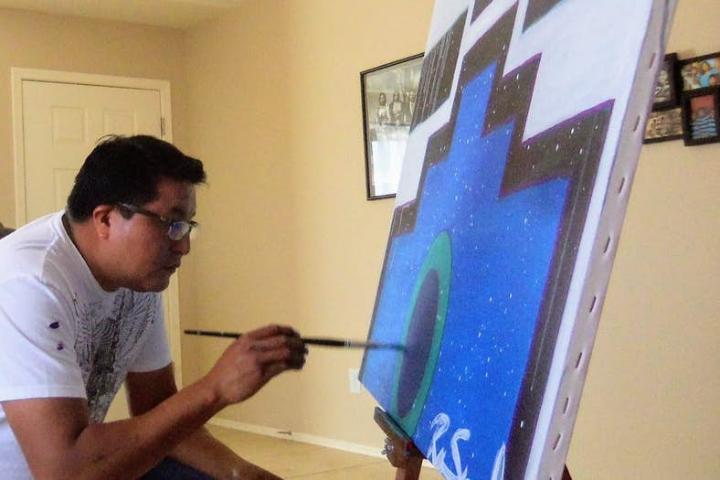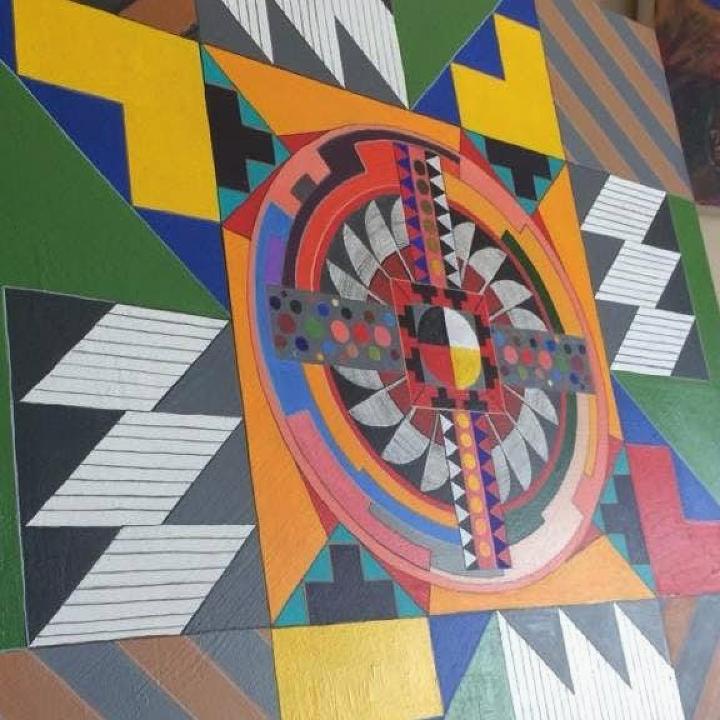 |
Canku Ota
|
 |
|
(Many Paths)
|
||
|
An Online Newsletter
Celebrating Native America
|
||
|
August 2020 - Volume
18 Number 8
|
||
|
|
||
|
'Everybody In The
World' Was Asking For Rance Sneed's Art
|
||
|
by Eddie Chuculate -
Indian Country Today
|
||
When Phoenix resident Rance Sneed first started getting the sniffles around June 18, the 48-year-old artist thought it was his annual summer bout with allergies. When he still had them a week later at a drum group rehearsal, he was told that a member of the group had contracted the coronavirus, and that he should get tested, said his father, David Sneed Sr., 69. After Rance got tested at the Gila River Reservation on June 26, his symptoms worsened to include severe headaches, dehydration, upset stomach and a cough. Sneed, who had no known underlying health conditions and wasn't on medication, never went to the hospital and died in his bed on July 6. He never knew that he had COVID-19, the deadly disease caused by the coronavirus, because his test results came back positive two days after his death. Arizona became one of the hot spots in the world for the virus this summer with long lines for testing and full intensive care wards at hospitals. As of July 23, 150,659 people in the state had contracted the coronavirus and 2,976 had died of it, according to the New York Times tracker. "I kind of think he knew he had it," David Sneed Sr., Gila River Pima and Hopi, said. "I think he didn't want anybody to panic or get excited." The father and son lived together in south Phoenix in the Laveen area. Sneed Sr. said he got up that morning as usual around 7 to make coffee but strangely heard no radio or TV coming from Rance's room.He knocked a couple times before entering and found his son deceased. Paramedics said he'd likely died late at night or early that morning. "I didn't even know he was sick," said his mother, Estelle Barehand, 70, Gila River Pima. "My oldest son came to my job and told me he had passed on. I'm still in shock but I'll just have to come to grips with it." Sneed complained in Facebook posts leading up to his death of a painful nasal COVID-19 test, migraine-like headaches and being parched, and joked about "killer" hangovers, although he hadn't drank in years. Rance Raymond Sneed, Gila River Pima and Hopi, was born Oct. 6, 1971, in Phoenix.After graduating from North Phoenix High School, he enrolled at the Institute of American Indian Arts in Santa Fe, New Mexico, in 1993 and graduated in December 1995 with an associate degree in two-dimensional arts. "I was always telling them (children) to take some college courses," said his former stepmother, Martha Yazzie-Valencia, Navajo, 64. She lives in Ahwatukee, Arizona. "That was my mantra. Thank god he honored me by going on to school. "His dad and I played a critical role in his schooling. The first painting he ever did he won a ribbon somewhere and he gave me that painting. The IAIA school kick-started his whole career." Rance was one of the first people Bryon Archuleta, Ohkay Owingeh Pueblo, met when he arrived on the IAIA campus as a new student in the fall of 1993. "We just kind of gravitated toward each other by the concert T-shirts I was wearing," said Archuleta, 47, who graduated from IAIA in spring of 1996. "We used to do a lot of hikes in Diablo Canyon or the Santa Fe Mountains with the (IAIA) Rec Club," Archuleta said from his northern New Mexico home on the reservation. "It's hard to believe he's gone. He was so full of life and positivity. He had found sobriety and still had that youthful spirit. "Some of us have downtimes and age catches up with us. But he was still spry, had a lot of energy. It never seemed to go away with him: He always had that positive vibe." As a work-study monitor, Archuleta recollected keeping the studio open extra hours while students including Sneed would work on paintings all night in preparation for midterms or finals, usually cranking rock music into the predawn hours. "He was a big U2 fan and into 1980s New Wave British (music)," Archuleta said. "He wasn't too much of a metalhead but went to shows with us just to hang out."The two remained in contact over the years, usually meeting up in Santa Fe for the annual Indian Art Market each August. David Sneed Sr. said when he bought his house in 2011 Rance asked if he could move in with him. "I said sure. He had just recovered from alcohol (abuse) and from that time on was in recovery, going to Native American AA (Alcoholics Anonymous) meetings."He liked going and making friends with people from those organizations. … He was 9-10 years in recovery and still going to meetings, even a week or two before he got sick. He'd go to one or two every week." Rance was a lifelong skateboarder and also loved getting around Phoenix on a bike, or putting it on the front of a public bus to go even farther. He liked going to the movies and eating out, David Sneed Sr. said. Rance loved to travel, having visited Ireland and New York City, and loved returning to Santa Fe and Albuquerque to meet up with friends and old classmates. The Sneeds turned a bedroom into an art studio for Rance, where he'd spend hours painting or sketching alongside his three dogs: Biscuit, a Chihuahua mix; Jake, a Rhodesian ridgeback mix; and Momo, a pure-breed husky. "He was trying to get himself known, which was a hard thing for him, getting his work out there," David Sneed Sr. said."He'd go to as many shows as he could. He sold some things but a lot of times he wouldn't sell and he'd come home disappointed. I'd tell him that's the way it goes, sometimes. "I'll always remember him sitting in his art room painting or drawing, having his earbuds on or watching a video." Rance completed a commission for the Banner Alzheimer's Institute's Healthy Minds Through Native American Traditions campaign in Phoenix, where his painting design was used on a website, buttons, pamphlets and magnets, that he was especially proud of.
Rance left behind 20-25 acrylic-on-canvas paintings in his studio, some in their garage, and designs and ideas in sketchbooks. David Sneed Sr. plans on cataloguing the work and taking pictures for documentation. "Everybody in the world has been asking for one," he said. 'Protector' looked after elders, camped at Standing Rock 100 nights Rance became interested in issues concerning Native Americans, making a trip to South Dakota to join the global protest over the planned Dakota Access oil pipeline which threatened Standing Rock Sioux sacred water. Sneed stayed nearly 100 days through a bitter winter of 2016-17, sometimes chopping wood and delivering it to families in camp, and visiting his friend Tim Hunts-In-Winter's elderly parents just to sit with them and speak encouraging words. He stayed even after the camp ended. On the day he died, the U.S. District Court for the District of Columbia in Washington ruled that the pipeline must be shut down pending an environmental review and emptied of oil by Aug. 5 in a yearslong victory for tribes, protesters and environmentalists. "It really surprised me when he got his activist side," Yazzie-Valencia said. The concern for others was a lifelong thread, his dad said. "Tim called him Protector. He always watched over people — being selfless. He did the same thing with my parents when they were getting into their older years," David Sneed Sr. said. "All of us brothers and sisters were working and they were bedridden. We had to take care of them all the time and Rance would come by, too, and do that with his uncle Daniel (Sneed), and we were real thankful for that." Rance had a sister, Michelle Sneed, who died at age 34 in October 2010 in a car wreck. At her wake, Rance spoke some words that shocked his dad. "Apparently, when Michelle was like 7 or 8 they were swimming at the Verde River when they were living at Fort McDowell (in Arizona)," David Sneed Sr. said. "She slipped and fell and Rance (four years older) jumped in the river and swam after her and saved her from drowning. He never told anybody about it until the wake." Rance is survived by his parents and stepmother, and sister Senoria Silvas (Sneed), 53, of San Bernardino, California, brother David Sneed Jr., 52, Gila River, Arizona; and sisters Bernadine Sneed, 49, Gila River; Brianna Lynn Rhodes (Sneed), 37, Gila River; and Tesla Sneed, 32, of Phoenix.Rance was buried July 16 on the Gila River Reservation just south of Phoenix in a service that started in predawn darkness and was streamed live on Facebook. Only a limited number of family and friends were allowed due to reservation social distancing requirements. Sneed Sr. and Hunts-In-Winter used flashlights to read from notes before the sun came up. The temperature hit 111 degrees later that day. Sneed Sr., who has tested negative for the virus twice in July, wishes to thank family and friends who contributed to an online account to help defray funeral expenses.He also said a memorial will be held next year on July 5-6, likely on the reservation, for family or friends who were unable to attend the funeral. Eddie Chuculate, Creek/Cherokee, is a writer based in Minneapolis.
Banner
Alzheimer’s Institute - Native American Outreach Program |
||||
|
|
|
|
||
|
|
||
| Canku Ota is a free Newsletter celebrating Native America, its traditions and accomplishments . We do not provide subscriber or visitor names to anyone. Some articles presented in Canku Ota may contain copyright material. We have received appropriate permissions for republishing any articles. Material appearing here is distributed without profit or monetary gain to those who have expressed an interest. This is in accordance with Title 17 U.S.C. Section 107. | ||
|
Canku Ota is a copyright ©
2000 - 2020 of Vicki Williams Barry and Paul Barry.
|
||
 |
 |
|
|
The "Canku
Ota - A Newsletter Celebrating Native America" web site and
its design is the
|
||
|
Copyright ©
1999 - 2020 of Paul C. Barry.
|
||
|
All Rights Reserved.
|
||

